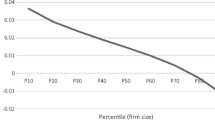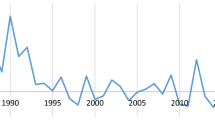Abstract
The purpose of this study is to assess under what conditions exchange rate volatility generates a positive effect on an exporting firm’s labour demand. As the exchange rate volatility increases, so does the value of the export option, provided that firms are flexible with respect to international trade. Higher volatility increases the potential gains from trade and can increase the demand for labour. The firm’s trade flexibility can be interpreted as a real hedging strategy when financial markets are incomplete. In many newly industrializing countries and emerging economies financial markets are imperfect or risk sharing markets are just starting to develop at a rather slow pace.
Similar content being viewed by others
Notes
See for example Battermann et al. (2008).
De Grauwe (2007) argues that within the EU the elimination of transaction costs is another source of gains in economic efficiency arising from a single currency, and it is certainly the most visible gain from the monetary union.
For an explanation see e.g. Sandmo (1971a).
In the standard theory of a price taking firm under certainty the profit function is usually assumed convex. A higher output price makes the firm adjust its optimal output policy, see e.g. Varian (1992).
The exchange rate process can be interpreted as a mean reverting stochastic process. The bulk of literature dealing with forward pricing and optimal hedge decisions focusses on evolutions expressed by standard geometric Brownian motion (GBM). The problem with GBM is that in many cases price changes are not independent and prices tend to return to an average level. For a discussion, see Broll et al. (2010).
Considering the case of a normal good, the income effect is clearly positive but nothing can be said about the absolute values of the single effects and hence the sign of the net effect.
References
Bacchetta P, van Wincoop E (2000) Does exchange rate stability increase trade and welfare? Am Econ Rev 90:1093–1109
Bacchetta P, van Wincoop E (2005) A theory of the currency denomination of international trade. J Int Econ 67:295–319
Battermann HL, Broll U, Wahl JE (2008) Utility functions of equivalent form and the effect of parameter changes on optimum decision making. Econ Theory 34:401–414
Bini-Smaghi L (1991) Exchange rate variability and trade: why is it so difficult to find any empirical relationship? Appl Econ 23:927–936
Black F, Scholes M (1973) The pricing of options and corporate liabilities. J Polit Econ 81:637–654
Broll U, Clark E, Lukas E (2010) Hedging mean-reverting commodities. J Manag Math 21(1):19–26
Broll U, Eckwert B (1999) Exchange rate volatility and international trade. South Econ J 66:178–185
Broll U, Eckwert B (2006) Transparency in the foreign exchange market and the volume of international trade. Rev Int Econ 14:571–581
Broll U, Wahl JE, Zilcha I (1995) Indirect hedging of exchange rate risk. J Int Money Financ 14:667–678
Caves RE (2007) Multinational enterprise and economic analysis. Cambridge University Press, Cambridge
Chen Y, Funke M (2002) Exchange rate uncertainty and labour market adjustment under fixed exchange rates, working paper 779. CESifo, München
De Grauwe P (2007) Economics of monetary union, 7th edn. Oxford University Press, Oxford
Dellas H, Zilberfarb BZ (1993) Real exchange rate volatility and international trade: a re-examination of the theory. South Econ J 59:641–649
Doehring B (2008) Hedging and invoicing strategies to reduce exchange rate exposure: a euro-area perspective. Economic papers 299. European Commission, Economic and Financial Affairs
Franke G (1991) Exchange rate volatility and international trading strategy. J Int Money Financ 10:292–307
Friberg R (1998) In which currency should exporters set their prices? J Int Econ 45:59–76
Friberg R, Wilander F (2008) The currency denomination of exports—a questionnaire study. J Int Econ 75:54–69
Funke K, Koske I (2008) Does the law of one price hold within the EU? A panel analysis. Int Adv Econ Res 14:11–24
Gagnon JE (1993) Exchange rate variability and the level of international trade. J Int Econ 34:269–287
Kawai M, Zilcha I (1986) International trade with forward-futures markets under exchange rate and price uncertainty. J Int Econ 20:83–98
Krugman PR (1989) Exchange rate instability. MIT, Cambridge
Lane PR (2001) The new open economy macroeconomics: a survey. J Int Econ 54:235–266
McKenzie M (1999) The impact of exchange rate volatility on international trade flows. J Econ Surv 13:71–106
Merton R (1973) Theory of rational option pricing. Bell J Econ 4:141–183
Obstfeld M, Rogoff K (1995) Exchange rate dynamics redux. J Polit Econ 103:624–660
Sandmo A (1970) The effect of uncertainty on saving decisions. Rev Econ Stud 37:353–360
Sandmo A (1971a) On the theory of competitive firm under price uncertainty. Am Econ Rev 61:65–73
Sandmo A (1971b) Portfolio theory, asset demand and taxation: comparative statics with many assets. Rev Econ Stud 44:369–379
Schmidt CW, Broll U (2009) Real exchange rate uncertainty and U.S. foreign direct investment: an empirical analysis. Rev World Econ 145:513–530
Sercu P, Uppal R (2003) Exchange rate volatility and international trade: a general equilibrium analysis. Eur Econ Rev 47:429–441
Varian HR (1992) Microeconomic analyses, 3RD edn. Norton, New York
Wong KP (2007) Optimal export and hedging decisions when forward markets are incomplete. Bull Econ Res 59:67–81
Wong KP (2008) Does market demand volatility facilitate collusion? Econ Model 25:696–703
Acknowledgements
We would like to thank our anonymous referee for very constructive and helpful comments. Furthermore we thank the editor of this Journal (P.J.J. Welfens) and Carsten Eckel for helpful discussions.
Author information
Authors and Affiliations
Corresponding author
Rights and permissions
About this article
Cite this article
Broll, U., Hansen-Averlant, S. Exchange rate volatility, international trade and labour demand. Int Econ Econ Policy 7, 423–436 (2010). https://doi.org/10.1007/s10368-010-0150-3
Published:
Issue Date:
DOI: https://doi.org/10.1007/s10368-010-0150-3




